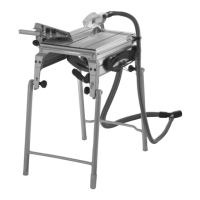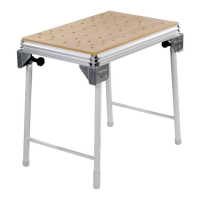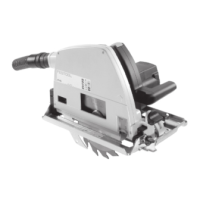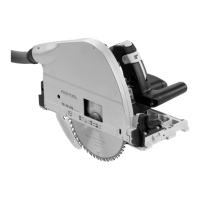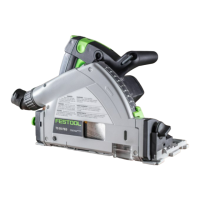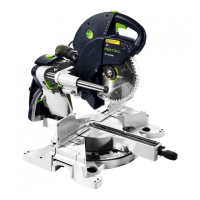15
P R E C I S I O -
GB
- Use a suitable device to support long work-
pieces and ensure that they are horizontal.
- Pull the plug from the main power socket be-
fore changing tools and rectifying faults such
as removing trapped splinters.
- Do not remove offcuts or other workpiece
parts from the cutting area while the tool is
still running and until the saw blade stops.
- If the saw blade is blocked, switch the machine
off immediately and disconnect the mains
plug. Do not remove the jammed workpiece
until you have done this.
- Cutting rebates or grooves is only permitted
with a suitable protective device fi tted, e.g. a
protective tunnel over the saw table.
- Do not use circular saws for cutting slots
(grooves in workpiece).
- Before transporting the machine, make sure
that the top protective guard covers the top
section of the saw blade.
- Do not use the top protective cover as a handle
for transportation!
- When not in use, store the push stick in the
holder provided on the machine.
5.2 Emission levels
Noise emissions have been measured in accord-
ance with the specifi cations in EN 61029. These
specifi cations apply for operation as a trimming
saw and bench-mounted circular saw.
Noise level
Sound power level, idling 91 dB(A)
Sound power level,
during operation 103 dB(A)
Measuring uncertainty allowance K = 3 dB
Workplace emission levels
Workplace emission, idling 77 dB(A)
Workplace emission,
during operation 90 dB(A)
CAUTION
The noise produced during work may damage
your hearing.
Wear ear protection!
Measured acceleration < 2.5 m/s²
The specifi ed emissions values (vibration, noise)
– are used to compare machines.
– They are also used for making preliminary
estimates regarding vibration and noise loads
during operation.
– They represent the primary applications of the
- The cutting width of the saw blade must be
larger and the standard blade thickness nar-
rower than the thickness of the spacer wedge
(2.2 mm).
- The tool must be suitable for the material to
be processed.
- Deformed or cracked saw blades and saw
blades with blunt or broken cutting edges
must not be used.
- Transport and store the tools in a suitable re-
ceptacle;
- Only use the machine if all safety devices are
in their correct positions, the machine is in
good condition and has been well maintained.
- Replace a worn or damaged (e.g. bedded in)
tabletop immediately.
- Operating personnel must have received ade-
quate training in the use, set-up and operation
of the machine.
- Faults on the machine, including the separat-
ing guards or the tool, must be reported to
maintenance staff immediately upon discov-
ery. The machine must not be used until the
fault has been eliminated.
-
Wear suitable personal protec-
tive equipment: ear protection
to reduce the risk of hearing
loss, safety goggles, a dust
mask to prevent inhalation of
harmful dust, protective gloves
when working with raw materials and when
changing tools.
- To minimise noise, the tool must be sharpened
and all noise reducing elements (covers etc.)
must be properly adjusted.
- When cutting wood, connect the machine to a
dust extractor corresponding to EN 60335-2-
69, dust category M.
- Never process material containing asbestos.
- Make sure that there is adequate lighting in
the room or workplace.
- Always assume the correct position before
starting work:
- front at the operating end,
- facing the machine,
- next to the cutting line.
- Use the accompanying workpiece holder to
guide the workpiece accurately past the saw
blade.
- Use the accompanying spacer wedge and pro-
tective cover. Make sure the cover is set as de-
scribed in the operating instructions.

